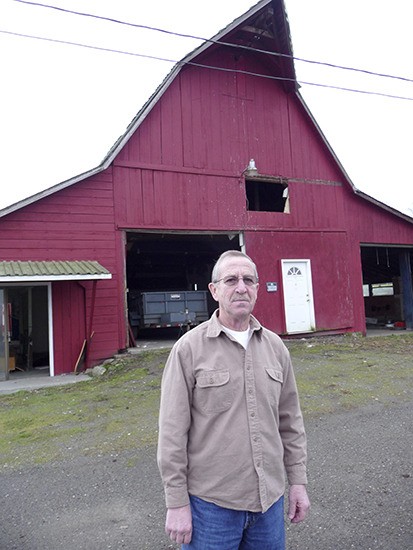Some barns are beautiful with intricate cupolas and shapely gambrel roofs.
Others are just plain Janes, built for function only, without an eye to the esthetic.
Such is a barn that Mark Smith acquired in September on Harrison Road. Recently he posted fliers through the Sequim-Dungeness Valley Chamber of Commerce which in effect say, “Take my barn — please!”
The family company, JOJACO Properties, owned by Smith, his wife Aleta and daughters Jode Beauvais and Jacquie Wilskey, has several adjoining parcels on Harrison Road and as good neighbors, its owners are committed to cleaning up the neighborhood.
“The new owners say blow it up, burn it down, get it out of our sight!” reads Smith’s flier.
He may not be looking for such drastic measures, but Smith certainly wants some good use to come of the barn — by someone else.
“We removed two 20-yard dump trucks of junk out of it and still have some to go,” Smith said. “The biggest reason I’m doing this is to get the property cleaned up. It’s been a mess for 15 years. The neighbors are very excited about the new ownership because the property’s been neglected. They’re all very happy to get the property cleaned up.”
Smith is entertaining several options: Lease it to someone who will remodel it for a business, part out the barn and sell its lumber or have someone dismantle it and rebuild it on another property.
Smith recalls the 3,000-square-foot dairy barn with a 1,000-square-foot loft from the early 1950s and assumes it was built in the 1940s. In the 1970s his parents purchased the property and later sold it. The loft still has a steel trolley for moving hay to the hay mow. Fir beams, probably about a foot thick, support the roof and fir boards are visible from inside at the roofline.
At some point in its history, sheds were attached on both sides of the main barn and an addition, on waist-high concrete blocks, was put on the back as milking parlor for dairy cows.
Research by Judy Stipe of the Museum & Arts Center in the Sequim-Dungeness Valley didn’t turn up the barn builder’s name and everyone she talked to said it has no historical significance.
“It’s not any unique style,” Smith said. “The main barn is not in bad shape but to remodel it to be commercially viable is going to take quite a bit of work. I’ve had three or four folks call, so we’ll see. Tearing it down, that’s a possibility. If I do take it down, I will try to repurpose the materials.
“There are a lot of large frame timbers and the flooring in the loft could be reused. I believe a lot of the wood came out of the Carlsborg Sawmill, where the Industrial Park is now.”
Smith said he has a timeline of six months to make a decision on the barn’s fate.
Contact him at 683-3737 to see the barn and share ideas.




